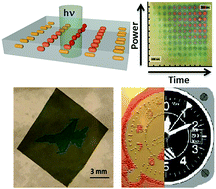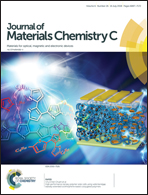Low-energy, nanoparticle reshaping for large-area, patterned, plasmonic nanocomposites†
Abstract
Compliant, robust films with pixelated, voxelated or gradient distribution of plasmonic properties are enabling for technologies from colorimetric sensors, filters, and gradient index optical elements to art. Spatially multiplexing different plasmonic effects, however, is challenging. To address this challenge, we demonstrate a post-film fabrication process that enhances gold nanorod (AuNR) reshaping with chemistry. Mild annealing or broadband non-coherent light sources provide sufficient heating to drive localized redox processes that lead to an isovolumetric reduction of the surface-to-volume ratio of CTAB stabilized AuNRs in polyvinyl alcohol (PVA). Single crystallinity is retained. The reshaping rate in the presence of these redox processes occurs in excess of 100× faster (seconds) than previous reports that utilize increased surface diffusion as temperatures approach the particle melting point (days). Using the process's dependency on reactant concentration, broadband, multi-exposure optical processing preserves particle alignment, enables multi-color patterning, and produces gradients of the longitudinal plasmon resonance of at least 0.01 eV μm−1 (3 nm μm−1).



 Please wait while we load your content...
Please wait while we load your content...
